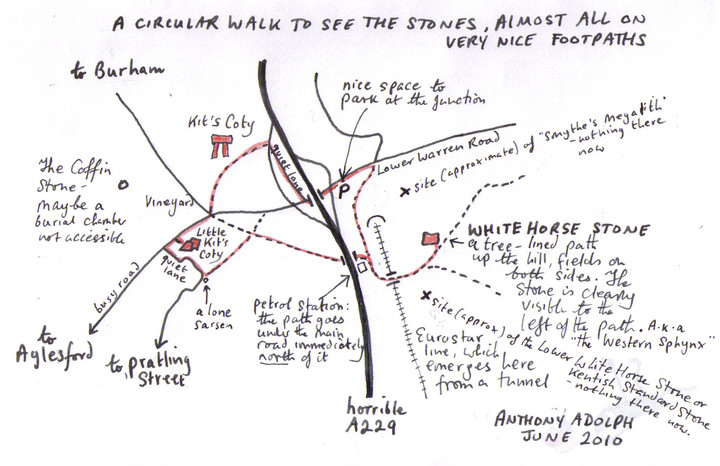The White Horse Stone is important because it reminds us of the Neolithic presence here: whilst the railway cutting was being dug, a Neolithic long house was found, with ‘and undefined bronze age timber circle plus a late bronze/early iron age settlement’. The stone is important, too, for the legends that have become attached to the stones, that now focus, inevitably, on this one, the only one that is left in this immediate spot. The Welsh historian Nennius (c. 800s AD) tells us that, in the mid-400s AD, after the withdrawal of the Roman legions from Britain (410 AD), the king who emerged in Kent (Ceint) was Guoyrancgonus (or Vorancgonus), of unknown origin, though more likely than not an elderly Roman military official who had stayed on, or the son of such a soldier. Guoyrancgonus’s rule was cut short by the High King, Vortigern, who gave Kent to the Jutish mercenary leader Hengist, in return for Hengist’s daughter Renwein.
For this and other outrages, Vortigern was deposed and his sons Vortimer and Catigern fashioned an army of the sons of the Romano-British, dusting off old, discarded standards and brushing rust off kit left behind by the Imperial legions, and set out to drive out the Jutes. History does not recall whether Guoyrancgonus was of their number, but I would like to think he was.
The North Downs are broken by a series of river valleys that flow south-north into the Thames, including the Darenth Valley and then, the next to the east, the Medway. The Romano-British brothers’ first battle was in the Darenth Valley and, against the odds, they were victorious. The Jutes fell back to the next river, the mighty Medway, making their stand at Aylesford, that the Jutes called Episford and the British, Nennius tells us, called Set Thirgabail. Here, the British princes made their second attack, their motley legion and cavalry routing the Jutes at the ford itself and driving the enemy back up the slope of the downs, if the legend is correct, to here, where the White Horse Stone stands. The date assigned to the battle by the Anglo-Saxon Chronicle is 455 AD.
Here, Geoffrey of Monmouth relates, Horsa, the brother of Hengist, came face-to-face with Catigern: Germanic battle-axe clashed with Roman sword: each met its bloody mark, and both princes were slain. Horsa’s white horse standard came clattering down onto the now lost Kentish Standard Stone. A folk tale of a ghostly flaming horse and rider, said to be seen here sometimes, may recall the burning of the bodies after the battle. But Vortimer bore his slain brother Catigern up onto the crest of the downs and buried him in the Neolithic longbarrow that now bears his name – Kit’s Coty . Already some 2,000 years or more old, the longbarrow was 180 feet long, and contained, perhaps, several internal burial chambers of upright sarsens supporting capstones. It is all gone now, victim to rain and plough, all except one of set of three uprights, and a capstone. This stands alone, encircled by railings to keep the curious at bay, and looks out west (as the barrow itself did once) over the Medway Valley.
Having buried Catigern, Vortimer pressed east, trouncing Hengist’s army twice more, once, perhaps, at Stone near Faversham, and finally in the marshy desolation of Thanet, where the Jutes took refuge in their longboats and skulked away back to Jutland. The story ends tragically, however, for Renwein later poisoned Vortimer, her husband Vortigern regained the throne, and allowed Hengist and his following of Jutes, Angles and Saxons to return – this time, for all Aurelius Ambrosius and Arthur tried to emulate Vortimer – never to leave.
That is the story of the White Horse Stone, and Kit’s Coty, and the fall of Britain.























